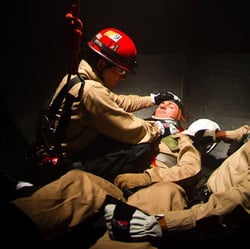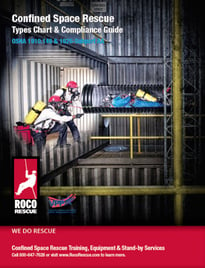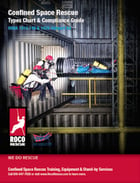Can’t I Just List “911” as My Confined Space Rescue Service?
 Simply put, No. We get this question all the time. Sure, with proper vetting of the rescue service and mutual agreement, you can list 911 as your rescue plan within your Permit Required Confined Space Entry program. However, there are clear precautions that must be taken and put into place.
Simply put, No. We get this question all the time. Sure, with proper vetting of the rescue service and mutual agreement, you can list 911 as your rescue plan within your Permit Required Confined Space Entry program. However, there are clear precautions that must be taken and put into place.
In the world of OSHA Standard language, we have a clear answer in this case. OSHA 1910.146, Appendix F spells it out very clearly.
“The employer should meet with the prospective rescue service to facilitate the evaluations required by 1910.146(k)(1)(i) and (k)(1)(ii). At a minimum, if an off-site rescue service is being considered, the employer must contact the service to plan and coordinate the evaluations required by the standard. Merely posting the service's number or planning to rely on the 911 emergency phone number to obtain these services at the time of a permit space emergency would not comply with paragraph (k)(1) of the standard.
You cannot get a much clearer answer than that from an OSHA Standard. And, keep in mind, while Appendix F is listed as “non-mandatory,” this does not mean that you do not have to comply with it. Using the method described is the non-mandatory part.
So, no, you cannot simply list 911 as your rescue service. You can however make an agreement with a private or municipal rescue service to provide that service provided you have evaluated the service to determine that they can perform the confined space rescue services needed for your facility.
If the rescue service becomes unavailable while an entry is underway, does it have the capability of notifying you so that the entry operation can be canceled?
For the employer, this is where an evaluation of the rescue service comes into play. OSHA 1910.146 Appendix F clearly outlines the need for employers to evaluate a prospective rescue service before relying on their services.
Once that occurs, one of the biggest challenges is determining how to make sure the municipal rescue service is available when you need them. Will they be available when you are ready to make entry, and what if the rescue service gets another call? If the rescue service becomes unavailable while an entry is underway, does it have the capability of notifying you so that the entry operation can be canceled?
Evaluating Rescue Response Capabilities
According to OSHA, the rescue service must be evaluated for:
- Ability to respond in a timely manner considering the hazards identified.
- Proficiency with rescue-related tasks and equipment.
- Ability to function appropriately while rescuing entrants from types of permit spaces identified.
The rescue service selected must be:
- Capable of reaching the victim(s) in a timely manner appropriate for the hazards identified.
- Equipped and proficient in performing the needed rescue services.
- Willing to provide the service. Employers may not rely on an outside service that is unwilling to provide rescue services.
 Appendix F provides a valuable means to ensure that both the rescuers and the employer know the requirements and that proper agreements are in place prior to confined space entry operations. Roco Confined Space Compliance Guide and Types Chart includes Appendix F along with information and checklists for conducting an (A) Initial Evaluation, and (B) Performance Evaluation.
Appendix F provides a valuable means to ensure that both the rescuers and the employer know the requirements and that proper agreements are in place prior to confined space entry operations. Roco Confined Space Compliance Guide and Types Chart includes Appendix F along with information and checklists for conducting an (A) Initial Evaluation, and (B) Performance Evaluation.
Critical factors include response time and availability. According to OSHA, the response time must be appropriate for the types of known or potential hazards affecting the confined spaces at the employer’s facility – and the rescue service must be available to respond in a timely manner during entry operations.
It is the employer’s responsibility, both morally and legally, to engage with the rescue service that is being considered. If you have identified an off-site team as the contracted rescue service in your confined space program, which includes municipal rescue, it is crucial that you take all the necessary steps to vet the agency as being a good fit to protect your employees. To document the arrangement, a written agreement is highly recommended. Click here to view a Sample Agreement to Provide Rescue Response.
Confined Spaces Require Special Rescue Skills and Equipment
Other than larger municipal departments, it is rare for local emergency responders to have the required confined space rescue resources including specialized training and equipment. Any shortfalls in an effective response must be addressed by the employer or confined space owner. This includes training, equipment, staffing, or other requirements to ensure a response appropriate for the types and hazards of the spaces onsite. Any rescue service would need to be trained and equipped in advance to face the many hazards and obstacles of permit-required confined space rescue.
OSHA states in section (d)(4) of 1910.146 that “the Employer shall provide rescue and emergency equipment needed to comply with paragraph (d)(9) of this section, except to the extent that the equipment is provided by rescue services…” This is where an employer and a public safety agency may enter a cooperative arrangement beyond what is expected of the emergency responder's normal response duties.
Conclusion
With careful planning, thorough communications, and proper training and equipment, relying on a private or municipal rescue response for confined space rescue can work. As an employer, it is your responsibility to make sure the rescue service is adequately prepared, equipped, and willing to provide confined space rescue services.
Additional OSHA References:
1910.146(d)(9) Develop and implement procedures for summoning rescue and emergency services, for rescuing entrants from permit spaces, for providing necessary emergency services to rescued employees, and for preventing unauthorized personnel from attempting a rescue;
1910.146(k)(1) An employer who designates rescue and emergency services, pursuant to paragraph (d)(9) of 1910.146(k)(1)(i). Evaluate a prospective rescuer's ability to respond to a rescue summons in a timely manner, considering the hazard(s) identified;
1910.146(k)(2)(i) Provide affected employees with the personal protective equipment (PPE) needed to conduct permit space rescues safely and train affected employees so they are proficient in the use of that PPE, at no cost to those employees;
1910.146(k)(2)(ii) Train affected employees to perform assigned rescue duties. The employer must ensure that such employees successfully complete the training required to establish proficiency as an authorized entrant, as provided by paragraphs (g) and (h) of this section;
1910.146(k)(2)(iii) Train affected employees in basic first-aid and cardiopulmonary resuscitation (CPR). The employer shall ensure that at least one member of the rescue team or service holding a current certification in first aid and CPR is available; and
1910.146(k)(2)(iv) Ensure that affected employees practice making permit space rescues at least once every 12 months, by means of simulated rescue operations in which they remove dummies, manikins, or actual persons from the actual permit spaces or from representative permit spaces. Representative permit spaces shall, with respect to opening size, configuration, and accessibility, simulate the types of permit spaces from which rescue is to be performed.
Note to paragraph (k)(1)(i): What will be considered timely will vary according to the specific hazards involved in each entry. For example, 1910.134, Respiratory Protection, requires that employers provide a standby person or persons capable of immediate action to rescue employee(s) wearing respiratory protection while in work areas defined as IDLH atmospheres.
Additional Resources
- Confined Space Types Chart (pictured here)
- Evaluating Your Rescue Service
- Agreement to Provide Rescue Response
- Requirements for Rescue Plans




